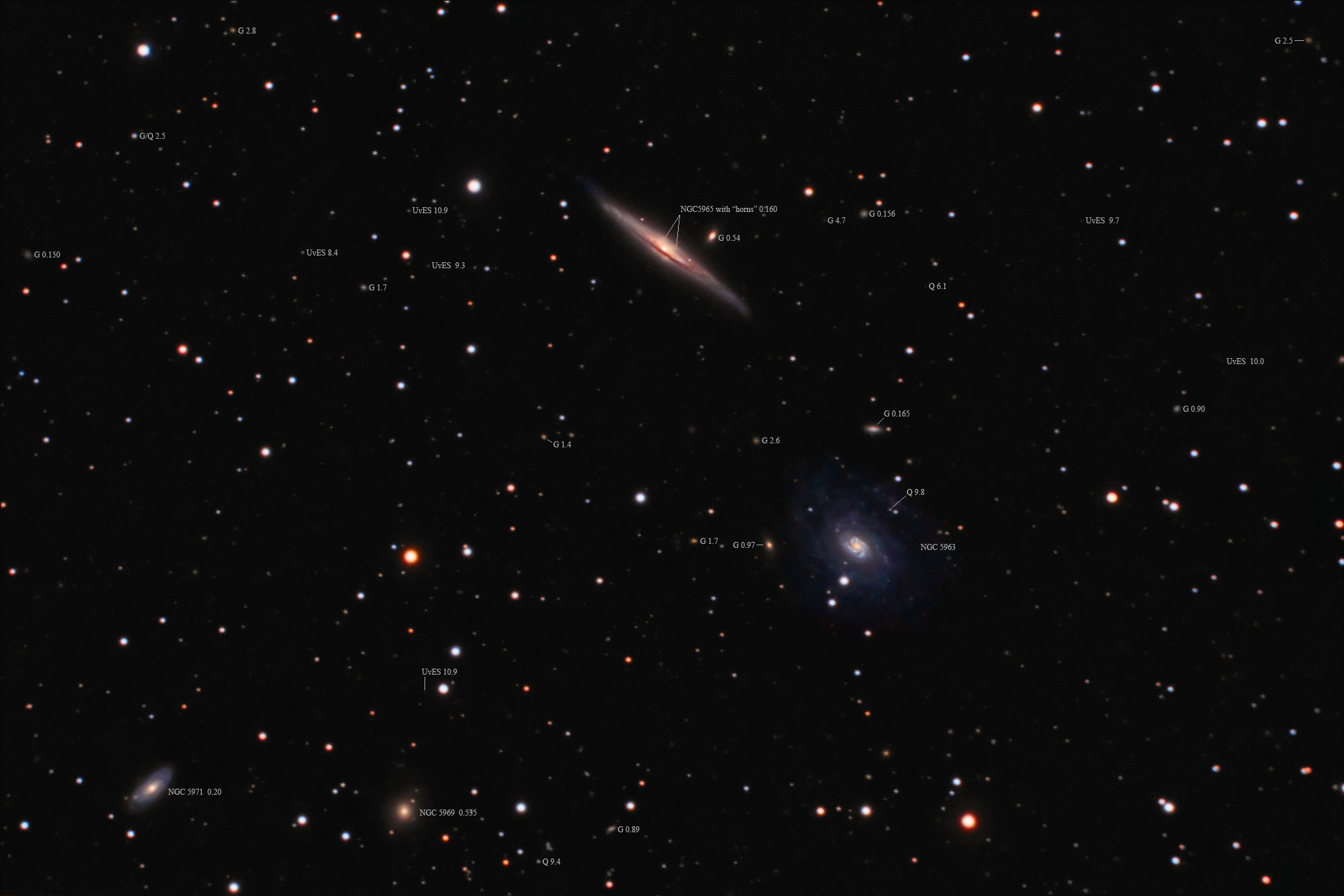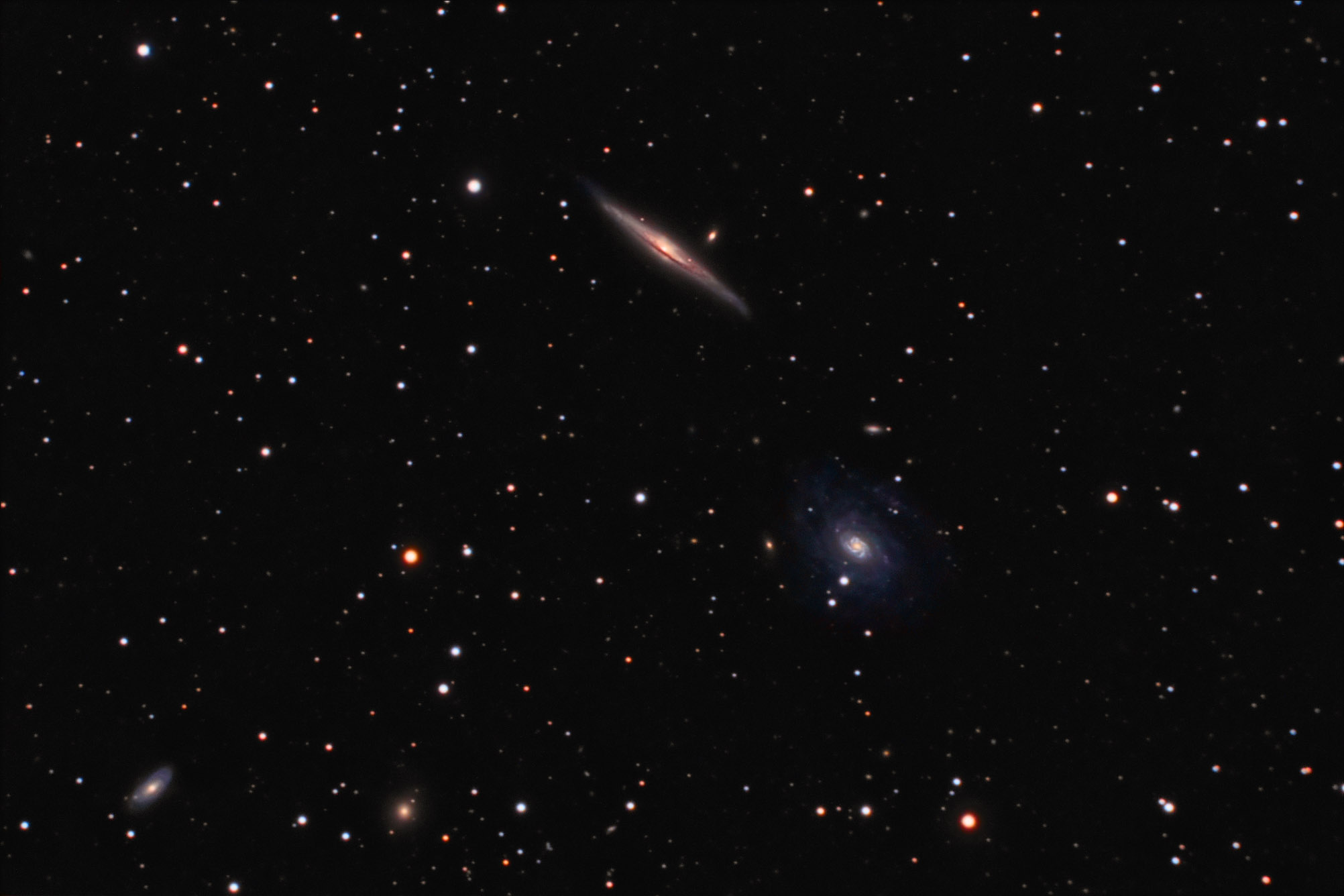| Description | Images |
Object name: NGC5963Designation(s): NGC5963, NGC5965, NGC5969, NGC5971, NGC 5963 and NGC 5965 are a nice pair of interesting, but unrelated, galaxies in Draco. NGC 5963 is a low surface brightness galaxy except for its core region which I had to greatly attenuate so it didn't overwhelm the image. It is thought to be rather close by but distance measurements vary wildly. Redshift would put it about 32 million light-years away. Tully-Fisher measurements range from 48 to 110 million light-years. All the more modern Tully-Fisher measurements range from about 90 to 110 million light-years. So maybe going with an average of 100 million light-years is about right? While NGC 5963 is an interesting, very blue, galaxy I was really interested in NGC 5965. Related Designation(s):2MASS J15332790+5633349, 2MASS J15340229+5641088, 2MASS J15345103+5627039, 2MASS J15353691+5627424, 2MASX J15332779+5633345, 2MASX J15340245+5641081, 2MASX J15345108+5627040, 2MASX J15353688+5627424, 2MASXi J1533282+563332, 2MASXi J1534022+564108, 2MASXi J1534510+562704, 2MASXi J1535368+562741, 2MFGC 12550, AKARI J1533272+563334, ASK 111598.0, ASK 111618.0, ASK 112665.0, ASK 693138.0, CGCG 1532.3+5645, CGCG 1532.8+5652, CGCG 1533.7+5638, CGCG 1534.4+5639, CGCG 297-015, CGCG 297-016, CGCG 297-018, CGCG 297-019, FGC 1918, GALEXASC J153327.72+563335.2 , GALEXASC J153451.06+562702.0 , GALEXASC J153536.89+562743.8 , HDCE 0903 NED004, IRAS 15322+5643, IRAS 15328+5651, IRAS F15322+5643, IRAS F15328+5651, ISOSS J15340+5640, KIG 0685:[VOV2007] 002, KPG 469A, KPG 469B, KTG 63A, KTG 63B, KTG 63C, LDCE 1112 NED004, MCG +09-25-058, MCG +09-25-059, MCG +09-26-002, MCG +10-22-020, NGC 5963, NGC 5965, NGC 5969, NGC 5971, NGC5963, NGC5965, NGC5969, NGC5971, NPM1G +56.0204, NSA 019957, NSA 019958, NSA 166299, NVSS J153328+563333, NVSS J153451+562704, PGC 055419, PGC 055459, PGC 055491, PGC 055529, RFGC 2994, SDSS J153327.85+563334.9, SDSS J153327.86+563334.8, SDSS J153327.86+563334.9, SDSS J153402.28+564108.5, SDSS J153402.29+564108.5, SDSS J153402.29+564108.6, SDSS J153451.02+562703.8, SDSS J153451.02+562703.9, SDSS J153451.03+562703.8, SDSS J153451.03+562704.1, SDSS J153451.04+562704.1, SDSS J153536.89+562742.0, SDSS J153536.89+562742.1, SDSS J153536.90+562742.1, SDSS J153536.90+562742.3, SDSS J153536.91+562742.3, UGC 09906, UGC 09914, UGC 09929, UNAM-KIAS 1360, UZC J153327.9+563334, UZC J153402.1+564110, UZC J153451.1+562703, UZC J153536.9+562741, [SLK2004] 1146, [TTL2012] 081580, [TTL2012] 094815, [TTL2012] 102096, |

